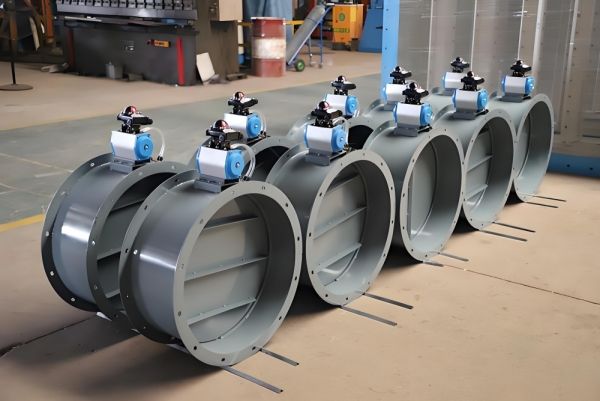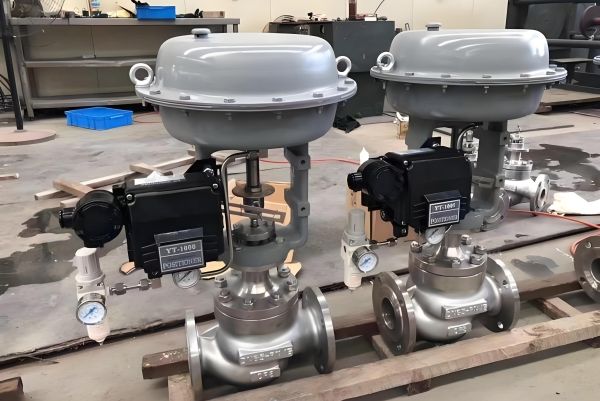Teoría de la tecnología: Soluciones industriales de automatización técnica… práctica… interesantes

En DELCO, comprendemos la importancia de la satisfacción del cliente y nos esforzamos por satisfacer las necesidades únicas de cada cliente. Como proveedor confiable de válvulas, nos comprometemos a brindar un excelente servicio al cliente y productos de alta calidad para garantizar un rendimiento y una longevidad óptimos. Al elegir a DELCO como su proveedor de aire de control de confianza, puede beneficiarse de conjuntos de válvulas personalizados diseñados específicamente para satisfacer sus requisitos, mejorando la eficiencia y reduciendo el tiempo de inactividad.
Resumen y soluciones a averías comunes de válvulas de control neumáticas
Los fallos comunes de válvulas de control neumáticas Se resumen de la siguiente manera:
(1) La válvula reguladora no funciona y los síntomas y motivos de la falla son los siguientes:
1. No hay señal, no hay fuente de gas. 1. La fuente de gas no está encendida. 2. Debido al contenido de agua en la fuente de gas, esta se congela en invierno, lo que provoca el bloqueo del conducto de aire o la falla del filtro y la válvula reductora de presión. 3. Falla del compresor. 4. Fuga de la tubería principal de la fuente de gas.
2. Hay una fuente de gas pero no hay señal. 1. Mal funcionamiento del regulador 2. Fuga de acero corrugado del posicionador 3. Placa de malla reguladora dañada
3. El localizador no tiene fuente de aire, 1. El filtro está bloqueado, 2. La válvula reductora de presión está defectuosa y 3. La tubería tiene fugas o está bloqueada.
4. El localizador tiene una fuente de gas pero no una salida. El orificio del acelerador del localizador está bloqueado.
5. Hay una señal pero no hay acción. 1. Desprendimiento del núcleo de la válvula, 2. El núcleo de la válvula se atasca con la sociedad o el asiento de la válvula, 3. El vástago de la válvula se dobla o se rompe, 4. El núcleo de la válvula del asiento de la válvula se congela o hay residuos de coquización. 5. El resorte del actuador murió debido a la falta de uso a largo plazo.
(2) El funcionamiento de la válvula reguladora es inestable. Los síntomas y causas de la falla son los siguientes:
1. Presión de fuente de gas inestable 1. Capacidad del compresor demasiado pequeña 2. Mal funcionamiento de la válvula reductora de presión
2. Presión de señal inestable 1. Constante de tiempo inadecuada del sistema de control 2. Salida inestable del regulador
3. La presión de la fuente de gas es estable y la presión de la señal también es estable, pero la acción de la válvula reguladora es inestable. Cuando la válvula de bola del amplificador en el localizador no está bien ajustada por la suciedad y el consumo de gas aumenta significativamente, se producirá una oscilación de salida. 2. El deflector de la boquilla del amplificador en el localizador no está paralelo y el deflector no puede cubrir la boquilla. 3. La tubería y la línea de salida tienen fugas de aire. La rigidez del actuador es demasiado baja. La resistencia a la fricción es alta durante el movimiento del vástago de la válvula y hay una obstrucción en el área de contacto.
(3) Ajuste de la vibración de la válvula. Los síntomas y causas de la falla son los siguientes:
1. La válvula reguladora vibra en cualquier apertura. 1. Soporte inestable 2. Hay fuentes de vibración cercanas 3. El núcleo y el revestimiento de la válvula están muy desgastados.
2. La válvula reguladora vibra cuando está en la posición completamente cerrada. 1. La válvula reguladora se ha seleccionado demasiado grande y se suele utilizar con una abertura pequeña. 2. La dirección del flujo del medio de la válvula de asiento único es opuesta a la dirección de cierre.
(4) El fenómeno y las razones del funcionamiento lento de la válvula reguladora son los siguientes:
1. El vástago de la válvula solo se mueve lentamente en una dirección. 1. El diafragma del actuador neumático de diafragma está dañado y tiene fugas. 2. El sello “O” del actuador tiene fugas
2. El vástago de la válvula es lento durante el movimiento alternativo. 1. Hay un bloqueo adhesivo dentro del cuerpo de la válvula. 2. El empaque de PTFE se ha deteriorado y endurecido, o el aceite lubricante del empaque de amianto y grafito se ha secado. Agregar 3 rellenos con demasiada fuerza aumenta la resistencia por fricción. Debido a que el vástago de la válvula no es recto, hay una alta resistencia por fricción. Las válvulas de control neumáticas sin localizadores también pueden causar lentitud.
(5) La fuga de la válvula reguladora aumenta y las razones de la fuga son las siguientes:
1. Cuando la válvula está completamente cerrada, hay una gran cantidad de fugas. 1. El núcleo de la válvula está desgastado y la fuga interna es grave. 2. La válvula no está correctamente ajustada y no se puede cerrar herméticamente.
2. La válvula no puede alcanzar la posición completamente cerrada. 1. La diferencia de presión media es demasiado grande, la rigidez del actuador es pequeña y la válvula no se puede cerrar herméticamente. 2. Hay objetos extraños dentro de la válvula. 3. El revestimiento está sinterizado.
(6) El rango de flujo ajustable se reduce. La razón principal es que el núcleo de la válvula se corroe y se vuelve más pequeño, lo que aumenta el caudal mínimo ajustable.
Comprender los fallos y las causas de las válvulas de control neumáticas puede permitir tomar medidas específicas para solucionarlos.
En DELCO, comprendemos la importancia de la satisfacción del cliente y nos esforzamos por satisfacer las necesidades únicas de cada cliente. Como proveedor confiable de válvulas de control, nos comprometemos a brindar un excelente servicio al cliente y productos de alta calidad para garantizar un rendimiento y una longevidad óptimos. Al elegir a DELCO como su proveedor de válvulas de control de confianza, puede beneficiarse de conjuntos de válvulas personalizados diseñados específicamente para satisfacer sus requisitos, mejorando la eficiencia y reduciendo el tiempo de inactividad.
Además, nuestros precios competitivos en reguladores de presión electrónicos le permiten ofrecer soluciones de primer nivel. Como uno de los principales fabricantes de válvulas de control, nos enorgullecemos de ofrecer válvulas confiables que no solo cumplen con los estándares de la industria, sino que también contribuyen a la rentabilidad general de su negocio. Al asociarse con DELCO, puede tener la tranquilidad de saber que está tomando una decisión inteligente para el éxito a largo plazo de su empresa.



